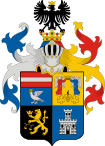Sárospatak
You can help expand this article with text translated from the corresponding article in Hungarian. (December 2009) Click [show] for important translation instructions.
|
Sárospatak | |
|---|---|
 Sárospatak Castle | |
| Country | |
| Regions | Northern Hungary |
| County | Borsod-Abaúj-Zemplén County |
| Area | |
| • Total | 100.5 km2 (38.8 sq mi) |
| Population (2009) | |
| • Total | 13,357 |
| • Density | 104.29/km2 (270.1/sq mi) |
| Time zone | UTC+1 (CET) |
| • Summer (DST) | UTC+2 (CEST) |
| Postal code | 3950 |
| Area code | 47 |
Sárospatak (German: Potok am Bodroch; Slovak: Šarišský Potok, Blatný Potok) (English rough translation: Muddy Stream or Muddy Brook on the Bodrog) is a town in Borsod-Abaúj-Zemplén county, northern Hungary. It lies 70 km (43 mi) northeast from Miskolc, in the Bodrog river valley. The town, often called simply Patak, is an important cultural centre.
History

The area has been inhabited since ancient times. Sárospatak was granted town status in 1201 by King Emeric. In the Middle Ages it was an important place due to its proximity to an important trade route leading to Poland. Its castle, built by Andrew II, is traditionally identified as the birthplace of his daughter Saint Elizabeth.
Sárospatak was elevated to the rank of free royal town by King Sigismund. In 1460, during the reign of King Matthias it received the right to hold a market. In 1575 a plague killed many of the inhabitants.
The Reformation began spreading into Hungary from this area. The first Protestant college, one of the most important colleges of Hungary at the time, was founded in Sárospatak in 1531. In 1650 Zsuzsanna Lorántffy, widow of George I Rákóczi prince of Transylvania invited the famous Czech educator Jan Comenius to Sárospatak. Comenius lived there until 1654, as a professor of the college, and he wrote some of his most important works there. The college (since 2000 a faculty of the University of Miskolc) now bears his name.
The owners of the castle of Sárospatak include many important individuals in Hungarian history. In the 16th century it was owned by the Dobó family. Bálint Balassi, the most important Hungarian poet of the century married Krisztina Dobó at the castle; the bride was the daughter of István Dobó, who defended the castle of Eger against the Ottoman Turks. Later the castle was owned by the Rákóczi family. The residents of the town took an active part in the revolution against Habsburg rule led by Francis II Rákóczi.
Today Sárospatak is a charming historical town and a popular tourist destination.
Tourist sights

People
This section needs expansion. You can help by adding to it. (December 2009) |
- Ladislaus IV of Hungary
- John Amos Comenius
- Lajos Kossuth
- Elisabeth of Hungary
- Bálint Balassi
- Francis II Rákóczi
- András Fáy
- George II Rákóczi
- Imre Makovecz
- János Erdélyi
- Mihály Tompa
- Miklós Izsó
- Ferenc Berényi
- Johann Grueber
- Ján Chalupka
- Frigyes Ákos Hazslinszky
- Gábor Nagy
- Ilona Zrínyi
- Zsuzsanna Lorántffy
Trivia
- The ceiling of one of the small rooms of the castle is decorated by frescoes of roses. The participants of the Wesselényi conspiracy held their secret meetings in this room. In Latin the term sub rosa means both "under the rose" and "in secret".
- Because of its cultural significance, Sárospatak is sometimes referred as "Athens of the Bodrog".
International relations
Twin towns — Sister cities
Sárospatak is twinned with:
References
- ^ "Krosno Official Website - Partner Cities".
 (in Polish) © 1998 - 2001 Urząd Miasta Krosna. Retrieved 2008-10-23.
(in Polish) © 1998 - 2001 Urząd Miasta Krosna. Retrieved 2008-10-23.



